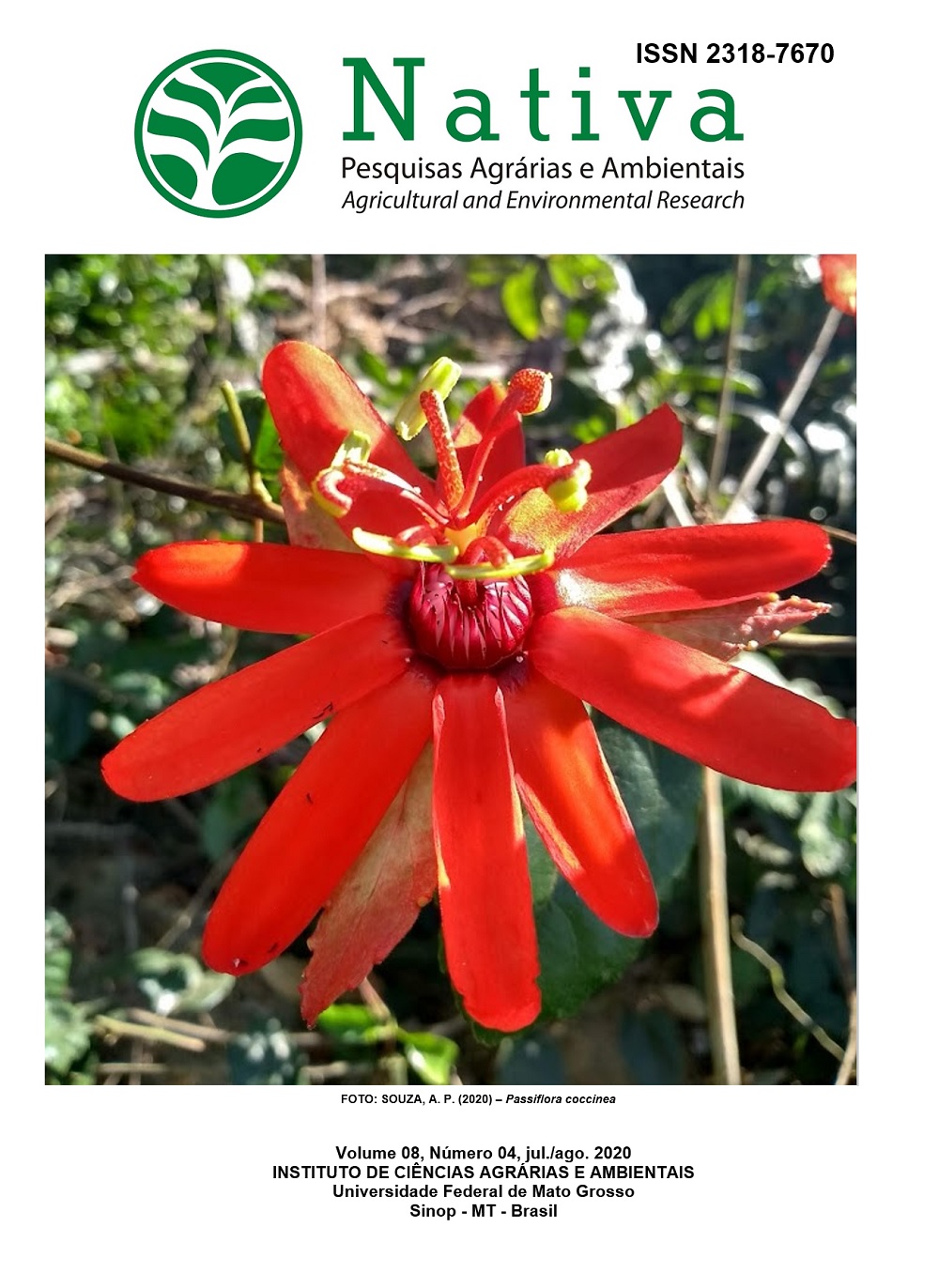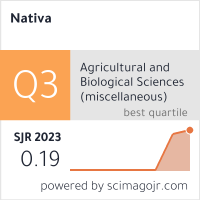POTENCIAL DENDROCRONOLÓGICO DE Jacaranda copaia QUE CONTIENE REGISTRO ENSO EN MADRE DE DIOS, PERÚ
DOI:
https://doi.org/10.31413/nativa.v8i4.10082Resumo
El objetivo de esta investigación fue construir la cronología de los anillos de crecimiento de la especie Jacaranda copaia (Achihua), analizar con los eventos más severos del fenómeno El Niño. Para ello se colectaron 10 árboles de J. copaia, de un bosque relicto de la región de Madre de Dios en el Perú. Se obtuvieron cuatro muestras por árbol, mediante la sonda de Pressler. El proceso, medición y análisis de los anillos de crecimiento fueron realizados mediante técnicas estándar de dendrocronología. Se construyó la cronología master de J. copaia, se determinó el incremento medio anual de la especie y la cronología fue relacionada con los eventos severos del fenómeno de El Niño. Los resultados muestran que J. copaia, presentan anillos de crecimiento distinto y anuales, delimitados por zonas fibrosas. La intercorrelación del ancho de los anillos de crecimiento entre árboles fue de 0,36. La edad máxima fue de 34 años. La relación entre la cronología y los eventos más severos del fenómeno El Niño fue de 0,18 y tuvo una relación clara en el año 1998. Los resultados revelan el potencial dendrocronológico de la especie J. copaia, en los bosques tropicales de Madre de Dios y para futuros estudios dendroclimáticos.
Palabras-clave: especie forestal; El Niño; anillos de crecimientos.
DENDROCHRONOLOGY OF Jacaranda copaia CONTAINING ENSO REGISTRY IN MADRE DE DIOS, PERU
ABSTRACT:
The objective of this investigation was to construct the chronology of the growth rings of the Jacaranda copaia (Achihua) species, to analyze with the most severe events of the El Niño phenomenon. For this, 10 J. copaia trees were collected from a relict forest in the Madre de Dios region of Peru. Four samples per tree were obtained using the Pressler's probe. The process, measurement and analysis of the growth rings were carried out using standard dendrochronology techniques. The J. copaia master chronology was constructed, the mean annual increase of the species was determined and the chronology was related to the severe events of the El Niño phenomenon. The results show that J. copaia, present distinct and annual growth rings, delimited by fibrous zones. The intercorrelation of the width of the growth rings between trees was 0,36. The maximum age was 34 years. The relationship between the chronology and the most severe events of the El Niño phenomenon was 0,18 and had a clear relationship in 1998. The results reveal the dendrochronological potential of the J. copaia species, in the tropical forests of Madre de Dios in for future dendroclimatic studies.
Keywords: forest species; El Niño; growth rings.
Referências
ALFARO, R. et al. Growth and reproduction respond differently to climate in three Neotropical tree species. Oecologia, v. 184, n. 2, p. 531–541, 2017. DOI 10.1007/s00442-017-3879-3.
ANDRADE, V. et al. Growth models for two commercial tree species in upland forests of the Southern Brazilian Amazon. Forest Ecology and Management, Reporter: Forest Ecology and Management, v. 438, p. 215–223, 2019. DOI 10.1016/j.foreco.2019.02.030.
APARECIDO, L. et al. Relevance of wood anatomy and size of Amazonian trees in the determination and allometry of sapwood area. Acta Amazonica, v. 49, n. 1, p. 1–10, 2019. DOI 10.1590/1809-4392201800961.
BELTRÁN, L. A.; VALENCIA, G. M. Anatomía de anillos de crecimiento de 80 especies arbóreas potenciales para estudios dendrocronológicos en la Selva Central, Perú. Revista de Biología Tropical, v. 61, n. 3, 2013. DOI 10.15517/rbt.v61i3.11778. Disponível em: http://revistas.ucr.ac.cr/index.php/rbt/article/view/11778. Acesso em: 9 mar. 2020.
BRIENEN, R. et al. Oxygen isotopes in tree rings are a good proxy for Amazon precipitation and El Nino-Southern Oscillation variability. Proceedings of the National Academy of Sciences, v. 109, n. 42, p. 16957–16962, 2012. DOI 10.1073/pnas.1205977109.
BRIENEN, R. W.; ZUIDEMA, P. A. Relating tree growth to rainfall in Bolivian rain forests: a test for six species using tree ring analysis. Oecologia, v. 146, n. 1, p. 1–12, 2005. DOI 10.1007/s00442-005-0160-y.
CALLADO, C. et al. Periodicity of growth rings in some flood-prone trees of the Atlantic Rain Forest in Rio de Janeiro, Brazil. Trees, v. 15, n. 8, p. 492–497, 2001. DOI 10.1007/s00468-001-0128-4.
DÉTIENNE, P. Appearance and Periodicity of Growth Rings in some Tropical Woods. IAWA Journal, v. 10, n. 2, p. 123–132, 1989. DOI 10.1163/22941932-90000480.
DOS SANTOS, G.; MILLER, R. Wood Anatomy of Jacaranda (Bignoniaceae): Systematic Relationships in Sections Monolobos and Dilobos as Suggested by Twig and Stem Wood Rays. IAWA Journal, v. 18, n. 4, p. 369–383, 1997. DOI 10.1163/22941932-90001502.
FELFILI, C. et al. Dendrochronological records of a pioneer tree species containing ENSO signal in the Pantanal, Brazil. Brazilian Journal of Botany, Reporter: Brazilian Journal of Botany, v. 41, n. 1, p. 167–174, 2018. DOI 10.1007/s40415-017-0434-8.
FOSTER, R.; PARKER, T.; GENTRY, A. (Org.). The Tambopata-Candamo reserved zone of southeastern Perú: a biological assessment. Washington, DC: Conservation International, Department of Conservation Biology, 1994. (RAP working papers, 6).
GARCÍA, A.; CAMARERO, J.; ESPINOSA, C. Intra-annual stem increment patterns and climatic responses in five tree species from an Ecuadorian tropical dry forest. Trees, v. 31, n. 3, p. 1057–1067, 2017. DOI 10.1007/s00468-017-1530-x.
HAYDEN, B. Annual growth rings in dry tropical forest trees. 2009. Library and Archives Canada = Bibliothèque et Archives Canada, Ottawa, 2009.
HERNÁNDEZ, L.; CASTELLANOS, H. Crecimiento diamétrico arbóreo en bosques de Sierra de Lema, Guayana venezolana: primeras evaluaciones. Interciencia, v. 31, n. 11, p. 787–793, 2006.
HOLMES, R. Computer-assisted quality control in tree-ring dating and measurement. Tree-ring bulletin, p. 11, 1983.
IAWA. IAWA list of microscopic features for hardwood identification. [s.l.]: IAWA Bull, 1989. v. 10.
KALNAY, E. et al. The NCEP/NCAR 40-Year Reanalysis Project. Bulletin of the American Meteorological Society, v. 77, n. 3, p. 437–471, mar. 1996. DOI 10.1175/1520-0477(1996)077<0437:TNYRP>2.0.CO;2.
LEÓN, W. Anatomía del Xilema secundario de diez especies de la familia Bignoniaceae de Venezuela. Acta Botánica Venezuelica, v. 30, n. 2, p. 361–384, 2007.
LISI, C. S. et al. Tree-ring formation, radial increment periodicity, and phenology of tree species from a seasonal semi-deciduous forest in southeast Brazil. Iawa Journal, v. 29, n. 2, p. 189–207, 2008.
MALHI, Y. et al. An international network to monitor the structure, composition and dynamics of Amazonian forests (RAINFOR). Journal of Vegetation Science, v. 13, n. 3, p. 439–450, 2002. DOI 10.1658/1100-9233(2002)013[0439:AINTMT]2.0.CO;2.
MENDIVELSO, H. et al. Time-dependent effects of climate and drought on tree growth in a Neotropical dry forest: Short-term tolerance vs. long-term sensitivity. Agricultural and Forest Meteorology, v. 188, p. 13–23, 2014. DOI 10.1016/j.agrformet.2013.12.010.
MENDIVELSO, H. A.; CAMARERO, J. J.; GUTIÉRREZ, E. Dendrochronology in Neotropical dry forests: methods, advances and applications. Ecosistemas, Reporter: Ecosistemas, v. 25, n. 2, p. 66–75, 2016. DOI 10.7818/ECOS.2016.25-2.08.
NOAA. NOAA’s Climate Prediction Center. 2017. Disponível em: http://origin.cpc.ncep.noaa.gov/products/analysis_monitoring/ensostuff/ONI_v5.php. Acesso em: 30 mar. 2018.
PACE, M. R. et al. Wood anatomy of major Bignoniaceae clades. Plant Systematics and Evolution, v. 301, n. 3, p. 967–995, mar. 2015. DOI 10.1007/s00606-014-1129-2.
PORTAL, L. Potencial Dendrocronológico de Árvores da Família Fabaceae na Floresta Tropical Amazônica do Peru. 2017. 149 f. Universidade Federal Rural do Rio de Janeiro, Rio de Janeiro - Brasil, 2017. Disponível em: https://tede.ufrrj.br/jspui/bitstream/jspui/2060/2/2017%20-%20Leif%20Armando%20Portal%20Cahuana.pdf.
QUINTO, H.; MORENO, F. Crecimiento de árboles en un bosque pluvial tropical del chocó y sus posibles efectos sobre las líneas de energía. REVISTA DE BIOLOGIA E CIÊNCIAS DA TERRA, v. 10, n. 2, p. 12–28, 2010.
SCHÖNGART, J. et al. Dendroecological Studies in the Neotropics: History, Status and Future Challenges. In: AMOROSO, M. et al. (org.). Dendroecology. Cham: Springer International Publishing, 2017. v. 231. p. 35–73. DOI 10.1007/978-3-319-61669-8_3. Disponível em: http://link.springer.com/10.1007/978-3-319-61669-8_3. Acesso em: 16 mar. 2020
SCHONGART, J. et al. Teleconnection between tree growth in the Amazonian floodplains and the El Nino-Southern Oscillation effect. Global Change Biology, Reporter: Global Change Biology, v. 10, n. 5, p. 683–692, 2004. DOI 10.1111/j.1529-8817.2003.00754.x.
TIMMERMANN, A. et al. Increased El Niño frequency in a climate model forced by future greenhouse warming. v. 398, p. 4, 1999.
VIEIRA, J. R.; GROENENDIJK, P.; LISI, C. S. Dendrochronological potential of four neotropical dry-forest tree species: Climate-growth correlations in northeast Brazil. Dendrochronologia, Reporter: Dendrochronologia, v. 53, p. 5–16, 2019. DOI 10.1016/j.dendro.2018.10.011.
VOLLAND, F. et al. Radial stem variations of Tabebuia chrysantha (Bignoniaceae) in different tropical forest ecosystems of southern Ecuador. Trees, v. 25, n. 1, p. 39–48, 2011. DOI 10.1007/s00468-010-0461-6.
WORBES, M.; RASCHKE, N. Carbon allocation in a Costa Rican dry forest derived from tree ring analysis. Dendrochronologia, v. 30, n. 3, p. 231–238, 2012. DOI 10.1016/j.dendro.2011.11.001.
Downloads
Publicado
Edição
Seção
Como Citar
Licença
Direitos Autorais para artigos publicados nesta revista são do autor, com direitos de primeira publicação para a revista. Em virtude de a aparecerem nesta revista de acesso público, os artigos são de uso gratuito, com atribuições próprias, em aplicações educacionais e não-comerciais.
A artigos publicados nessa revista, podem ser reproduzidos parcialmente ou utilizados como referência por outros autores, desde que seja cita a fonte, ou seja, a Revista Nativa.
Copyright for articles published in this journal are the authors, with first publication rights granted to the journal. The journal shows open access, and articles are free to use, with proper attribution, in educational and non-commercial.
The articles published in this journal may be reproduced in part or used as a reference by other authors, provided that the source is quoted.






